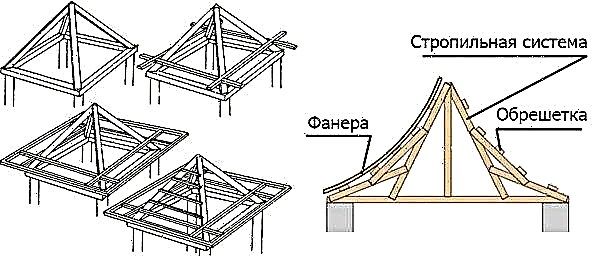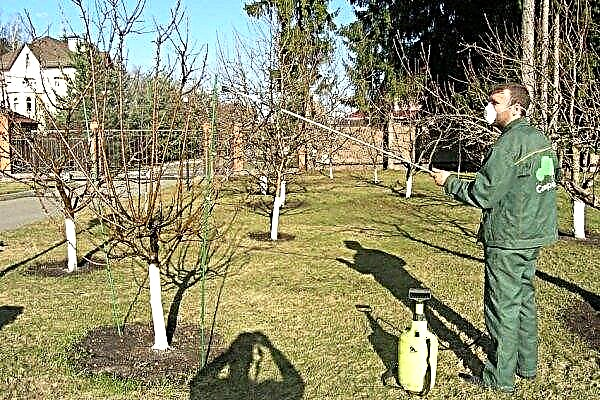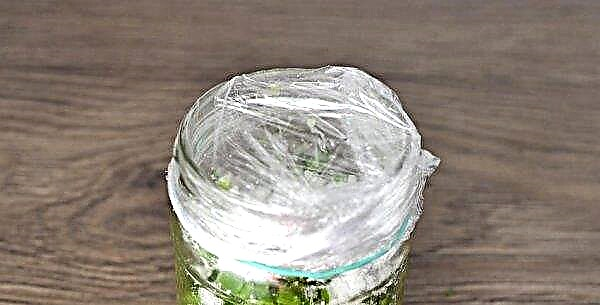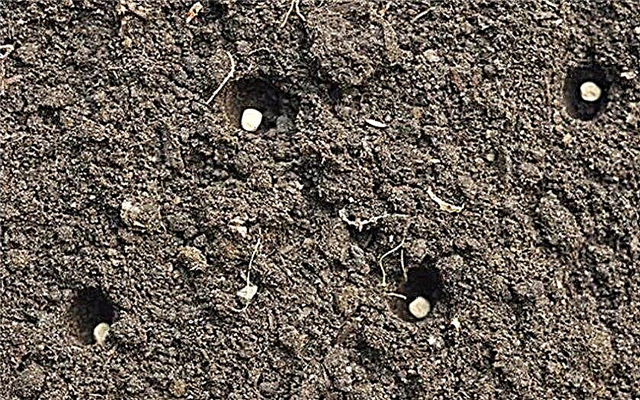Ficus Ali, or Benedict, is one of the most famous species of ficus living in a person’s house. It is appreciated for its spectacular crown and unpretentiousness in care, so often this plant can be found even in offices. Today in the world there are many of its hybrids, but in our article we will focus on the original ficus Ali and the features of its cultivation.
Botanical description of the plant
This flower comes from Southeast Asia, where in subtropical forests it can be found in the form of a tree-like plant about 18–21 m high. In the 19th century, it was discovered by the botanist Simon Binnendeijk, in whose honor the second name of the flower arose.
The homemade ficus ali (Ficus alii) is an evergreen tree from the Mulberry family.Did you know? In nature, there are ficus-stranglers. This name was given the form of ficus, whose representatives parasitize on other plants. They braid the carriers, feed on their juices, destroying them with their "arms", so the locals are actively trying to get rid of such pests.
You can find it by:
- a thin stem-stem up to 30-40 cm high, covered with dark bark;
- narrow leaves up to 30 cm long and up to 7–8 cm wide with sharpened tips;
- saturated dark green color of leaves with a glossy tint;
- branches sagging down under the weight of greenery;
- the original pattern on the leaf plate, which forms a thick vein in the center with small veins extending from it.

At home, the ficus practically does not bloom, and all its decorativeness lies in a beautiful crown.
| Root system | branched |
| Stem | tree-like, up to 40 cm tall |
| Leaf shape | elongated |
| Leaf color | dark green |
Growing conditions
Ficus is not particularly demanding in terms of living conditions in a house or apartment, but they also have their own preferences. Their observance contributes not only to the preservation of the decorativeness of the plant, but also to its healthy development.
Accommodation
The sight of Ali feels great, being under diffused light or in partial shade. For him, accommodation on the east or southeast side will be the best option.

If you plan to place it in other places, then take into account such features:
- lack of light will result in loss of color by the leaves;
- direct sunlight will cause burns, so when placed on the south side, be sure to shade it;
- the plant does not tolerate a change of place, so immediately choose a location for it, taking into account potential growth;
- the flower should not suffer from drafts.
Temperature mode
In addition to light, ficus Benedict loves and warmth. In summer, he will be comfortable at + 22 ... 24 ° С, and in winter the minimum allowable limit is + 16 ° С.
By itself, a change in air temperature on a ficus is not too affected, but a sharp drop in soil temperature is critical for it. It is highly recommended not to place the pot in the summer near air conditioners, and in winter, while the heating appliances are in operation, the ficus should be away from them.Important! When growing a flower, remember the simple rule: the warmer the room, the more light it needs, and the cooler, the shorter the daylight.
He loves the plant and fresh air: regular airing of the room will do him good.
Air humidity
The moisture level is not very important for the variety Ali, but if possible it is better to maintain it at the level of 50–70%.
On hot summer days, periodic spraying with warm, settled water or rubbing the leaves with a damp sponge will not hinder him. Well, if it is possible to place a household humidifier in the room at this time.

Home Care
In order for your ficus to always please with an elegant crown and a healthy look, it is enough to periodically water it, feed it and carry out a transplant.
Watering
These are hygrophilous plants, therefore it is better not to allow drying of the soil. Perform regular, but moderate, irrigation with standing or rainwater at room temperature. Ficus Ali is poured under the root, moistening the soil well throughout the pot.
The frequency of watering will depend on the temperature and humidity in the room. Experienced flower growers recommend orienting themselves on the upper (1-2 cm) soil layer in a flowerpot. As soon as it dries, the earth will become crumbly, which means it's time to moisten the flower.
In summer, the procedure is carried out more often, in winter - much less often. However, regardless of the season, remove excess water from the pan 20-30 minutes after watering, so as not to provoke root decay.
Top dressing
Ficus Benedict needs fertilizers during the period of active growth - from March to October, at which time they are applied once every 2 weeks. But in winter, this procedure should not be carried out.
For greater efficiency, it is better to alternate organic and mineral preparations for deciduous indoor plants, using only soil products. Spraying them with leaves of ficus is categorically contraindicated.
Important! If possible, fertilize the soil at the same time as watering it, then nutrients will be better absorbed.
Pruning
The formation of a crown in the species Ali is carried out as desired. If you remove the extra shoots, the plant quickly turns into a fluffy luxurious bush of compact size.
Some experiment lovers even plant several plant specimens in one pot, intertwining them with each other and eliminating excess leaves, shoots.

Transfer
The plant is transplanted as necessary when its roots become crowded in a pot. In young specimens, this does not happen more than once a year, but adult ficuses are transplanted every 2-3 years. At the same time, it is recommended to replace with it the topsoil every year - about 5-6 cm.
The transplant is always carried out in early spring, when the flower ends at rest. There are no special requirements for a plant pot - it should only be larger than the previous one, have a supply of space for future flower growth and have a drainage hole.
A layer of expanded clay or small stones is laid at the bottom to ensure a high-quality drain of water. Carefully approach the selection of soil for ficus Ali. The easiest way to get purchased special substrates for ficus or the more common mixture for palm trees.
If you prefer to prepare the soil yourself, then keep in mind: Ali does not like acidic and alkaline soils.
The following combinations can be used to fill the pot:
- turf, peat and sand in a ratio of 1: 1: 1 (best suited for young specimens);
- leafy soil, turf, sand, peat, humus (2: 2: 1: 1: 1) are suitable mainly for adult plants;
- leafy earth, turf, sand (2: 2: 1) with a pinch of charcoal.

The transplant itself takes several steps:
- Carefully remove the ficus from the pot so as not to damage its root system.
- At the bottom of the pot spread a small (1-2 cm) layer of drainage.
- Then the plant is lowered for drainage (make sure that it stands evenly, without distortions in one of the sides) and begin to sprinkle evenly on all sides with new soil.
- It is enough to fill 50-60% of the pot volume with it, and the remaining space should be supplemented with old soil.
Important! After abundantly moisten the soil and be sure to return the ficus to its previous habitat.
Breeding
At home, propagating ficus Ali is easiest with cuttings and layering.
At home, such types of ficuses are also grown, such as:
Cuttings
The advantage of this method is called the rapid rooting of the plant.
In addition, the process of propagation by cuttings will not take much time from the grower:
- In the spring and summer, select the appropriate stem shoot and cut (with scissors, pruner, knife) with an oblique incision.
- Dip it in warm, settled water and put in light partial shade, where the temperature is kept at + 20 ... + 24 ° С.
- On average, the cuttings need about 3 weeks for the appearance of roots. If the room at this time will be hotter than the specified temperature, it is advisable to spray the shoot every day to maintain air humidity. Also add water to the tank as it evaporates.
- As soon as the roots grow by 1.5–2 cm, the young plant can be planted in a pot.

Layering
This non-standard method of plant propagation is used when the ficus loses its decorative effect. To get a layering, a beautiful part of the crown is selected, which you want to save, and a strip of bark is removed from the trunk 2-3 cm lower from the trunk.
Wet moss is applied to the exposed place, and then this area is wrapped in polyethylene. Periodically check the condition of the moss and moisten it if necessary. After 2-3 weeks, roots will appear at the site of removal of the bark, and the top of the plant can be cut off for transplanting into a new pot. So rejuvenate ficus Ali if necessary.
Did you know? In Thailand, ficus is considered a symbol of the country.
Possible growing difficulties
The unpretentious and patient ficus of Benedict can periodically suffer from diseases or pests. Such troubles happen most often due to violation of the rules of care or its location in the wrong place.
Pests
Ficus can infect the following types of insects:
Try to get rid of pests when the first signs of their stay on the plant appear.
While there are not many, then remove the insects with a damp sponge, and then organize a warm shower for the plant. Well, if it is possible to wash the leaves with soap and water (dilute 1 teaspoon of grated laundry soap in 1 liter of water).
However, when there are too many pests, only insecticides will help to cope with them: the universal "Actellik", against the tick you can also try "Sunmayt", "Fitoverm".Did you know? Eastern peoples believe that if there are no children in the family, then it is worth growing a ficus in the house, and they will certainly appear.
Disease
Ficus Ali owners may experience the following plant problems:
- The leaves turn yellow. The reason for this is always lighting - if the flower is in the shade, then there is not enough light; if the ficus stands on without shading, then there is too much light.
- Leaves turn black. The plant suffers from sharp and significant (at least 7 ° C) temperature changes. Provide him a more stable environment.
- Black spots appear on the underside of the leaf, dots, or a reddish-brown coating appears on the stem. This is how fungus manifests itself (cercosporosis, anthracnose), which can be eliminated only by removing the affected areas and treating the plant with fungicides (for example, “Carbendazim”).
- Brown spots appear at the ends of the leaves. This may indicate overfeeding, too hot microclimate or insufficient humidity. Temporarily stop fertilizing, increase the frequency and duration of airing to lower the temperature (just avoid drafts). A tray with wet expanded clay, on which it is worth putting a pot with a flower, will help increase humidity.

It happens that ficus Ali discards leaves.
Various factors can lead to such consequences:
- waterlogging of the soil. In this case, the plant first wilts, wilts, and only after the leaves fall. Excess moisture provokes rotting of the roots, which negatively affects the leaves;
- change of habitat of the plant;
- lack of light. Under these conditions, flower growth slows down, its immunity decreases, and it becomes vulnerable to a number of diseases and pests. Try to increase the influx of natural light or compensate for its lack of artificial light;
- sunburn. If direct sunlight falls on the leaves, then first the plates frown, dry, and then completely fall off. To correct the situation, apply ficus and increase the number of sprays.
Did you know? Ficuses are famous for their ability to process toxic substances (benzene, phenol, etc.) into useful trace elements (amino acids, sugars).
Ficus Ali will decorate any home, adding exoticism to its unusual look. This plant does not require special living conditions or excessive attention in terms of care, so it is often placed in offices or workrooms.












